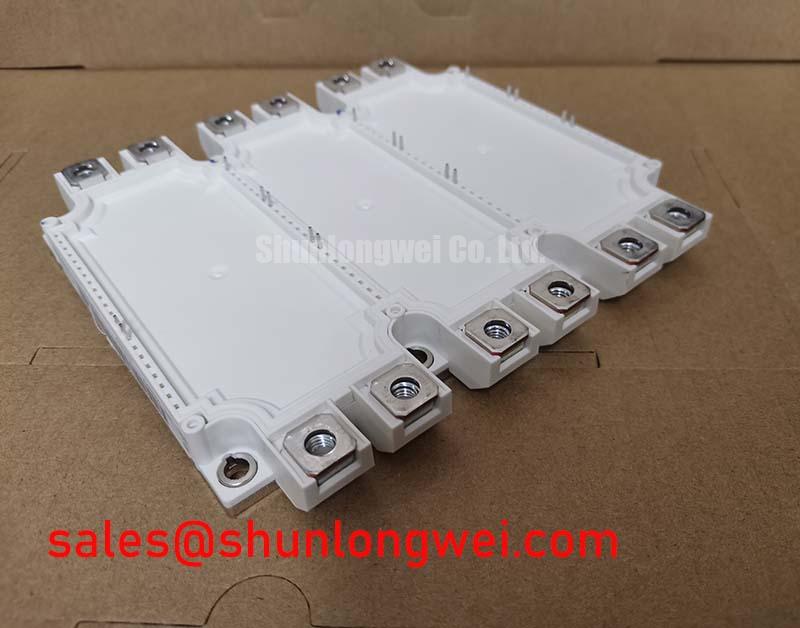Infineon FS450R12KE3: A Technical Analysis of a Robust, Low-Loss IGBT Module
Infineon FS450R12KE3: 1200V 450A EconoPACK™ 3 IGBT Module
Introduction and Core Highlights
The Infineon FS450R12KE3 is a half-bridge IGBT module that delivers a potent combination of low conduction losses and high operational robustness, leveraging Infineon’s TRENCHSTOP™ IGBT3 technology. This module is engineered for high-power converter systems where thermal efficiency and fault tolerance are paramount. Its positive VCE(sat) temperature coefficient is a key characteristic that inherently supports stable current sharing, which is a critical consideration when paralleling modules for higher power output.
- Core Specifications: 1200V | 450A | VCE(sat) (typ.) = 2.05V @ 125°C
- Key Advantages: Minimizes conduction losses, reducing heatsink requirements. Enables robust and simplified design for paralleled module configurations.
Download the Official FS450R12KE3 Datasheet (PDF)


Technical Analysis: Efficiency and Robustness by Design
A defining characteristic of the FS450R12KE3 is its low collector-emitter saturation voltage, VCE(sat), specified at a typical value of 2.05V with the junction at 125°C and at the nominal current of 450A. This parameter is directly proportional to the power lost as heat during the module’s on-state. Think of VCE(sat) as the electrical “friction” of the switch; a lower value means less energy is wasted as heat. This superior efficiency allows for smaller heatsink designs or higher power throughput for a given cooling system, directly impacting system cost and power density.
Beyond efficiency, the module is built for resilience in demanding industrial environments. The datasheet specifies a short-circuit withstand time of at least 10 microseconds at a DC link voltage of 800V. This provides a critical window for the gate drive protection circuitry to detect a fault condition and safely shut down the IGBT, preventing catastrophic failure. Combined with a maximum operating junction temperature of 150°C, the FS450R12KE3 offers a significant safety margin, ensuring reliable operation under heavy electrical and thermal loads.

Optimized Application Scenarios
The performance profile of the FS450R12KE3 makes it a strong candidate for a range of high-power applications:
- Motor Drives: The high current rating (450A nominal) and robust short-circuit safe operating area (SCSOA) are well-suited for the demanding torque and overload conditions in industrial motor control.
- Solar Inverters: Low switching and conduction losses, enabled by the TRENCHSTOP™ IGBT3 technology, are critical for maximizing the energy conversion efficiency in large-scale photovoltaic systems.
- Uninterruptible Power Supplies (UPS): The module’s high reliability and 1200V blocking voltage provide the necessary performance for commercial and industrial UPS systems that protect critical loads.
- Welding Power Supplies: The ability to handle high currents and rapid switching cycles makes it a dependable component for industrial welding applications.
Its balance of low losses, proven robustness, and parallel-friendly characteristics makes the FS450R12KE3 an excellent match for efficiency-focused, high-reliability power converter designs.
Key Specification Parameters for FS450R12KE3
| Absolute Maximum Ratings (T_vj = 25°C unless otherwise specified) | |
|---|---|
| Collector-Emitter Voltage (V_CES) | 1200 V |
| Continuous Collector Current (I_C,nom) | 450 A (T_C = 80°C) |
| Repetitive Peak Collector Current (I_CRM) | 900 A (t_p = 1 ms) |
| Gate-Emitter Voltage (V_GES) | ±20 V |
| Operating Junction Temperature (T_vj,op) | -40 to +150°C |
| Electrical & Thermal Characteristics (T_vj = 25°C unless otherwise specified) | |
| Collector-Emitter Saturation Voltage (V_CE,sat) | 2.05 V (typ. at I_C=450A, T_vj=125°C) |
| Gate Threshold Voltage (V_GE(th)) | 5.8 V (typ.) |
| Short Circuit Withstand Time (t_psc) | ≥ 10 µs (V_CC=800V, V_GE ≤ 15V, T_vj ≤ 150°C) |
| Thermal Resistance, Junction-to-Case (R_thJC) per IGBT | 0.045 K/W (max.) |
Engineer’s FAQ
- What makes the FS450R12KE3 suitable for parallel operation?
- The datasheet specifies a positive temperature coefficient for VCE(sat). This means as an individual IGBT heats up, its on-state resistance increases slightly, naturally encouraging current to be shared more evenly among parallel modules. This prevents thermal runaway in a single module and simplifies the overall system design for achieving higher power outputs.
- How should the thermal resistance (R_thJC) value be used in thermal design?
- The R_thJC value of 0.045 K/W (max) is a critical parameter for heatsink selection. It quantifies the thermal opposition from the IGBT junction to the module’s case. Engineers must use this value, along with the thermal resistance of the thermal interface material and the heatsink itself, to calculate the total expected temperature rise and ensure the junction temperature remains below the 150°C maximum during operation. Proper IGBT thermal design is crucial for reliability.
- What is the function of the integrated NTC thermistor?
- The built-in Negative Temperature Coefficient (NTC) thermistor provides a means for real-time temperature monitoring. Its resistance decreases predictably as the module temperature rises. A gate driver or system controller can read this resistance to infer the module’s temperature, enabling over-temperature protection and providing valuable data for system-level thermal management.
- Is the EconoPACK™ 3 an industry-standard package?
- Yes, the EconoPACK™ 3 is a widely adopted package in the power electronics industry. Its standard mechanical footprint and terminal layout can simplify system upgrades and sourcing for high-volume manufacturing.
Enabling Efficient and Reliable Power Conversion
By integrating low-loss TRENCHSTOP™ IGBT3 technology within the robust and industry-standard EconoPACK™ 3 housing, the FS450R12KE3 module provides a dependable foundation for high-power converter systems. Its electrical and thermal characteristics are specified to empower engineers to develop systems that are not only efficient but also resilient under demanding operational conditions, supporting the goals of increased power density and long-term reliability in modern power semiconductors.